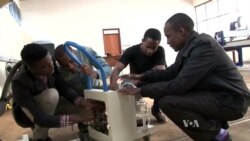An initiative called the Maker Movement at Kenya's University of Nairobi set out nearly two years ago to design effective, low-cost, locally sourced medical equipment that can improve maternal, infant and child health, and it has made great strides.
The work is important, because Kenya has to import much of its medical equipment and it can be quite costly. For instance, a conventional suction machine used to clear an infant’s airway after birth or during an operation can go for about $2,000.
But mechanical engineering student Joel Kabete and his classmates designed a machine that cost just $500 to make with a 3-D printer.
The project took two years.
"We use the local materials," Kabete said. "We can use the materials that we have now and come up with substances that can help not only the children but the society as a whole.”
Student Raphael Osoro was the brain behind a phototherapy machine, which took him six months to develop. The blue spectrum light emitted by the machine reduces the high bilirubin levels that cause jaundice in newborns.
Osoro noted that his machine cost a third as much as similar machines on the market, and it has been adapted for local needs.
“One unit should be used for one baby," he said, "but when you go to, for instance, Kenyatta National Hospital, they are putting three babies on one unit and the lighting is not effective. So we had to incorporate the size of around four babies and come up with this size.”
Gates Foundation funding
The Science and Technology Park of the University of Nairobi partnered with Concern Worldwide, an international humanitarian organization, and Kenyatta National Hospital to develop the prototypes. The Bill and Melinda Gates Foundation is funding the project.
One component that's missing from the Make Movement project: female students.
“We have a problem in that we’ve got a lot of innovations that go on, but we don’t have enough women in science," said Richard Ayah of the Science and Technology Park. "We don’t have enough women in technology and also women in engineering coming through. And a lot of the problems we have in society are because of gender imbalances.”
The suction machine is already being reviewed by the Kenya Bureau of Standards, which will decide whether it can be approved for use. But there may be more challenges ahead.
“We don’t have the ready-made policy to support the research and innovation of medical devices," said Edwin Maina of Concern Worldwide. " … We are having challenges with ensuring that the highly skilled manpower is focused on innovating around medical devices.”
The student engineers are optimistic, however, and they are already working on more designs.










